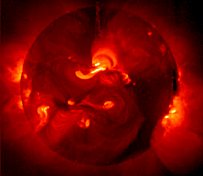 |
 |
 |
 |
 |
||
| Science of Light -> Ultraviolet |
|
Ultraviolet light rays lie between the x-ray and visible light spectrum. Ultraviolet (UV) light has shorter wavelengths than visible light. Though these waves are invisible to the human eye, some insects, like bumblebees, can see them! (Image of the bumblebee is courtesty of Mark Cassino.) Most of the ultraviolet light reaching the Earth is blocked by our
atmosphere's ozone layer and is very difficult to observe from the ground.
To study light in this region of the spectrum astronomers use high-altitude
balloons, rockets, orbiting observatories and satellites. At
ultraviolet wavelengths, most stars fade from view because they are too cool to emit such high energy light. But very young massive stars, some very old stars, bright nebulae, white dwarfs stars, active galaxies and quasars shine brightly in the ultraviolet. There are many different satellites that have helped us and continue to help us study the stars and galaxies in ultraviolet light. Some examples are the Hubble Space Telescope Observatory, NASA's Far Ultraviolet Spectroscopic Explorer (FUSE) satellite, and NASA's International Ultraviolet Explorer (IUE) satellite, which is now retired. The IUE was operational for over 17 years. NASA's Far Ultraviolet Spectroscopic Explorer (FUSE) astronomy satellite was retired for a few years and is now back in full operation. FUSE has obtained more than 52 million seconds of science data on everything from planets and comets in our solar system to distant quasars and active galaxies, and every major class of object in between. This information, compiled in the form of spectrographs rather than visual images, provides astronomers with details about the physical properties and characteristics of objects, from temperatures and densities to chemical makeup. Observations from the satellite have been used to discover an extended, tenuous halo of very hot gas surrounding our Milky Way galaxy, and have found evidence of similar hot gas haloes around other galaxies. To the left is a picture of the sun in "ultraviolet light".
Ultraviolet photography is a photographic process of recording images by using light from the ultraviolet (UV) spectrum only. There are two ways to use UV radiation to take photographs - reflected ultraviolet and ultraviolet fluorescence photography.
Reflected ultraviolet photography finds practical use in medicine, hospitals use UV lamps to kill microbes on surgical equipment and in the air of operating rooms). Food and drug companies also use UV lamps to sterilize their products. In criminology it can be used in detecting forged bank notes. UV light is also used in dermatology and theatrical applications. In addition to this, you experience the effects of ultraviolet light when you get a tan and when you go to the dentist, who uses the light to harden some of your dental fillings. You also see UV lamps in discos, where they make your clothes glow. This happens because substances in washing powder "fluoresce" when UV light strikes them. When you mark your possessions with a security marker pen, the ink is invisible unless you shine a UV lamp at it. Sunlight is the most available free UV radiation source, but the quality and quantity of the radiation depends on atmospheric conditions. A bright and dry day is much richer in UV radiation and is preferable to a cloudy or rainy day. Our atmosphere protects us from most of the UV rays coming from the sun. However, the percentage of waves that do break through can cause great damage to our skin.
|
|



 FUSE also has also detected molecular hydrogen in the atmosphere of the planet Mars for the first time. This has implications for the water history of Mars. In addition, FUSE observations first detected molecular nitrogen in dense interstellar gas and dust clouds, but at levels well below what astronomers had expected, requiring a return to the drawing board for theories of interstellar chemistry.
FUSE also has also detected molecular hydrogen in the atmosphere of the planet Mars for the first time. This has implications for the water history of Mars. In addition, FUSE observations first detected molecular nitrogen in dense interstellar gas and dust clouds, but at levels well below what astronomers had expected, requiring a return to the drawing board for theories of interstellar chemistry.